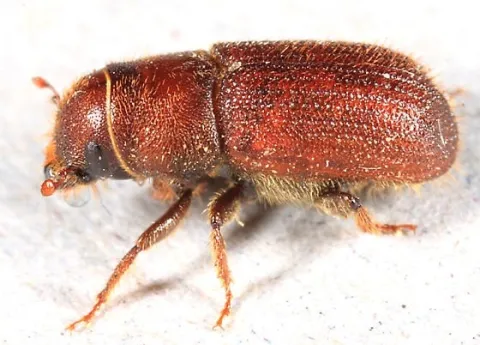
Red Turpentine Beetle
By Norman Smith UCCE Master Gardener
Most of us have seen the results of an infestation from this beetle - dead Monterey pine trees. But it is probably safer to say that most of us have not seen the culprit, the Red Turpentine Beetle. Like most bark beetles, it is small compared to other beetles, but is actually big for a bark beetle. The adult female beetle looks for Monterey pine trees that are under stress. Apparently stressed Monterey pines give off a certain chemical odor that the beetle can pick up on her antennae. As most of us know, we have had a lot of stressed Monterey pines in our area recently, due to a prolonged drought. Monterey pines that had a source of water during this drought were able to avoid being killed by the beetle - those that didn't, were not long for this world. After being attracted to a potential host tree, the adult beetle will bore into the bark. If she comes across a sap tube that is functioning properly, she is overwhelmed by sap and either pushed out of the hole or killed by being engulfed by sap. If this does not happen, she goes on to build an egg chamber. This is the beginning of an infestation in that tree and will most likely lead to its death. Somewhere along this process of forming an egg chamber, she will release a pheromone, attracting other Red Turpentine Beetles to the same tree. This overwhelming attack is usually more than the tree can overcome, especially a stressed tree.
A massive beetle attack can probably kill a tree by itself. As beetle borer holes begin to sever sap and water tubes in the tree, the roots starve to death and water can't be transported to the branches of the tree. But this beetle usually inoculates the tree with Blue Stain Fungus, and the mycelial growth also helps to plug up the sap and water tubes. This two-pronged attack invariably leads to tree death.
We have lost nearly all of our Monterey Pine trees here in the San Luis Obispo area. Cambria has lost thousands of trees from their Monterey Pine forests. A timely wet year two years ago has slowed the death of Monterey Pines but they are still occurring. My neighborhood has lost its share of Monterey Pines too, but two very large trees have been saved so far, due to heads up maintenance by our landscape professionals. Prior to the drought, additional water was supplied to these two large trees and so far they have escaped the water stress that attracts the beetle. Only time will tell if they can continue to live to a ripe old age.
Homeowners who have a dead or dying Monterey Pine in their yards should have it removed as soon as possible to prevent more beetles from emerging and infesting other trees. In fact, when the sap tubes begin to appear (see photo), even if the tree still looks healthy, you should have it cut down, as it will not recover.

